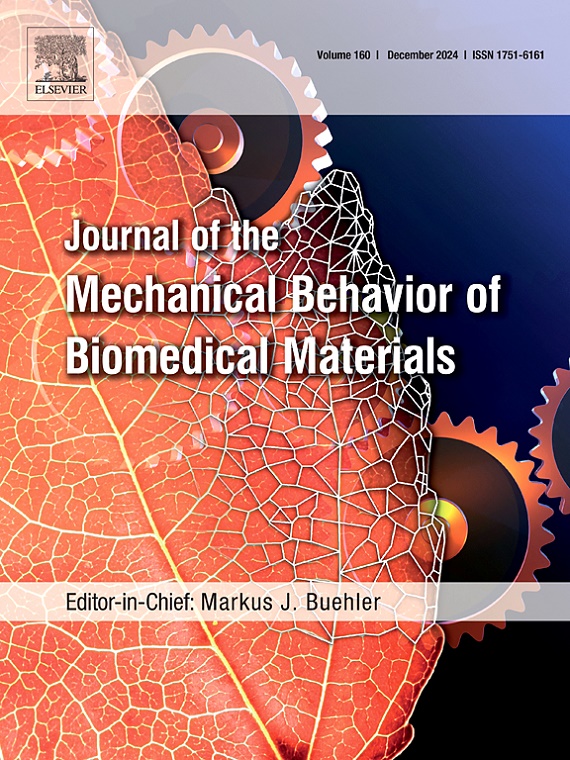Optimising dental restorative composites: Numerical and statistical analysis of polymerization shrinkage and elastic modulus effects
IF 3.3
2区 医学
Q2 ENGINEERING, BIOMEDICAL
Journal of the Mechanical Behavior of Biomedical Materials
Pub Date : 2025-03-22
DOI:10.1016/j.jmbbm.2025.106981
引用次数: 0
Abstract
Light-cured resin-based dental restorative composites face challenges from polymerization shrinkage, which induces stress, potentially leading to microleakage, debonding, and recurrent caries. The elastic modulus (E) of these composites also influences stress distribution, with high-stress concentrations potentially leading to fractures in restored teeth. While finite element analysis (FEA) has been used to understand stress distribution, there is a lack of comprehensive studies exploring the combined effects of volumetric polymerization shrinkage (PS%) and E on restored molars. No research has addressed the influence of these factors on stress intensity at crack tips during mastication after shrinkage. This study investigates how variations in E and PS% affect the stress distribution at the restoration-enamel junctions (REJ) and restoration under mastication stimuli and shrinkage. Additionally, the study examines the impact of E and PS% on the stress intensity factor at the crack tip of a restored molar tooth. A 3D model of an upper molar was created from scanned images, converted into a mesh using 10-node tetrahedral elements, and analysed with finite element methods. The values of E ranged from 5 GPa to 25 GPa, and PS% ranged from 1 % to 5 %. Results showed that maximum principal stress varied with different E and PS% values, with the lowest stress occurring at E = 5 GPa and PS% = 1 % and the highest at E = 25 GPa and PS% = 5 %. Changes in these parameters also affected the locations of peak principal stress. Additionally, stress intensity factors decreased with increasing E but rose with higher PS%. Changes in E and PS% influence where and how much the principal stresses occur at the REJ and during restoration in response to shrinkage and mastication stimuli. This highlights the crucial role of material properties in the performance and durability of restorations, providing evidence-based insights that could guide material selection for MOD-restored molar teeth, ultimately enhancing restoration longevity and clinical outcomes.
优化牙科修复复合材料:聚合收缩和弹性模量效应的数值和统计分析
光固化树脂基牙科修复复合材料面临聚合收缩的挑战,聚合收缩会引起应力,可能导致微渗漏、脱粘和复发性龋齿。这些复合材料的弹性模量(E)也会影响应力分布,高应力集中可能导致修复牙齿的断裂。虽然有限元分析(FEA)已被用于了解应力分布,但缺乏关于体积聚合收缩(PS%)和E对修复磨牙的综合影响的全面研究。目前还没有研究讨论这些因素对裂纹尖端收缩咀嚼过程中应力强度的影响。本研究探讨了在咀嚼刺激和收缩作用下,E和PS%的变化对修复-牙釉质连接处(REJ)应力分布和修复的影响。此外,研究还考察了E和PS%对修复磨牙裂纹尖端应力强度因子的影响。通过扫描图像创建上臼齿的三维模型,使用10节点四面体单元转换为网格,并使用有限元方法进行分析。E取值范围为5gpa ~ 25gpa, PS%取值范围为1% ~ 5%。结果表明:最大主应力随E和PS%值的不同而变化,在E = 5 GPa和PS% = 1%时应力最小,在E = 25 GPa和PS% = 5%时应力最大;这些参数的变化也影响了峰值主应力的位置。应力强度因子随E的增大而减小,随PS%的增大而增大。在收缩和咀嚼刺激下,E和PS%的变化影响REJ和修复过程中主应力发生的位置和程度。这突出了材料特性在修复体性能和耐久性中的关键作用,为mod修复磨牙的材料选择提供了基于证据的见解,最终提高了修复体的寿命和临床效果。
本文章由计算机程序翻译,如有差异,请以英文原文为准。
求助全文
约1分钟内获得全文
求助全文
来源期刊

Journal of the Mechanical Behavior of Biomedical Materials
工程技术-材料科学:生物材料
CiteScore
7.20
自引率
7.70%
发文量
505
审稿时长
46 days
期刊介绍:
The Journal of the Mechanical Behavior of Biomedical Materials is concerned with the mechanical deformation, damage and failure under applied forces, of biological material (at the tissue, cellular and molecular levels) and of biomaterials, i.e. those materials which are designed to mimic or replace biological materials.
The primary focus of the journal is the synthesis of materials science, biology, and medical and dental science. Reports of fundamental scientific investigations are welcome, as are articles concerned with the practical application of materials in medical devices. Both experimental and theoretical work is of interest; theoretical papers will normally include comparison of predictions with experimental data, though we recognize that this may not always be appropriate. The journal also publishes technical notes concerned with emerging experimental or theoretical techniques, letters to the editor and, by invitation, review articles and papers describing existing techniques for the benefit of an interdisciplinary readership.
 求助内容:
求助内容: 应助结果提醒方式:
应助结果提醒方式:


